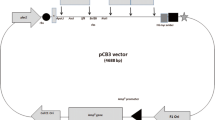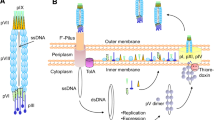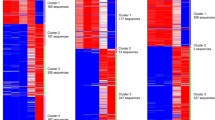Abstract
We have used a naive human single-chain fragment variable (scFv) library as a source of random shape repertoire to directly probe the altered surface chemistry of tumor cells. We reported previously the identification of more than 90 internalizing phage monoclonal antibodies targeting prostate cancer cells, including those that are hormone refractory. In this report, we describe the conversion of a panel of those scFvs into full-length human immunoglobulins (IgGs) and show that tumor specificity is retained. We have further shown that antibodies isolated from a naive phage display library can nevertheless be of high affinity towards target tumor cells. In addition, full-length IgGs retain the functionality of parental scFvs including the ability to rapidly enter target cells through receptor-mediated endocytosis and thereby to mediate efficient and specific intracellular payload delivery to tumor cells. We have used recombinant IgGs to immunoprecipitate target antigens and analyzed their molecular composition by mass spectrometry. We have identified one target antigen as activated leukocyte cell adhesion molecule (ALCAM)/MEMD/CD166 and have further studied tissue specificity of this internalizing ALCAM epitope by immunohistochemistry. Our study shows that cell type-specific internalizing human antibody can be readily identified from a naive phage antibody display library, characterized with regards to sequence, affinity, tissue specificity, and antigen identity, and modified genetically and chemically to generate various forms of targeted therapeutics.






Similar content being viewed by others
Abbreviations
- MAb:
-
Monoclonal antibody
- ScFv:
-
Single-chain variable domain fragment
- CaP:
-
carcinoma of the prostate
- AR:
-
androgen receptor
- ILs:
-
immunoliposomes
- MTX:
-
methotrexate
- K D :
-
dissociation equilibrium constant
- LC–MS/MS:
-
liquid chromatography–tandem mass spectrometry
- IHC:
-
immunohistochemistry
- ALCAM:
-
activated leukocyte cell adhesion molecule
References
Jemal A, Kulldorff M, Devesa SS, Hayes RB, Fraumeni JF Jr (2002) A geographic analysis of prostate cancer mortality in the United States, 1970–89. Int J Cancer 101:168–174
Rini BI, Small EJ (2001) An update on prostate cancer. Curr Opin Oncol 13:204–211
Cude KJ, Montgomery JS, Price DK, Dixon SC, Kincaid RL, Kovacs KF, Venzon DJ, Liewehr DJ, Johnson ME, Reed E, Figg WD (2002) The role of an androgen receptor polymorphism in the clinical outcome of patients with metastatic prostate cancer. Urol Int 68:16–23
Tolcher AW, Sugarman S, Gelmon KA, Cohen R, Saleh M, Isaacs C, Young L, Healey D, Onetto N, Slichenmyer W (1999) Randomized phase II study of BR96-doxorubicin conjugate in patients with metastatic breast cancer. J Clin Oncol 17:478–484
Kasuya Y, Lu ZR, Kopeckova P, Minko T, Tabibi SE, Kopecek J (2001) Synthesis and characterization of HPMA copolymer–aminopropylgeldanamycin conjugates. J Control Release 74:203–211
Noble CO, Kirpotin DB, Hayes ME, Mamot C, Hong K, Park JW, Benz CC, Marks JD, Drummond DC (2004) Development of ligand-targeted liposomes for cancer therapy. Expert Opin Ther Targets 8:335–353
Fair WR, Israeli RS, Heston WD (1997) Prostate-specific membrane antigen. Prostate 32:140–148
Magee JA, Araki T, Patil S, Ehrig T, True L, Humphrey PA, Catalona WJ, Watson MA, Milbrandt J (2001) Expression profiling reveals hepsin overexpression in prostate cancer. Cancer Res 61:5692–5696
Varambally S, Dhanasekaran SM, Zhou M, Barrette TR, Kumar-Sinha C, Sanda MG, Ghosh D, Pienta KJ, Sewalt RG, Otte AP, Rubin MA, Chinnaiyan AM (2002) The polycomb group protein EZH2 is involved in progression of prostate cancer. Nature 419:624–629
Dhanasekaran SM, Barrette TR, Ghosh D, Shah R, Varambally S, Kurachi K, Pienta KJ, Rubin MA, Chinnaiyan AM (2001) Delineation of prognostic biomarkers in prostate cancer. Nature 412:822–826
Hubert RS, Vivanco I, Chen E, Rastegar S, Leong K, Mitchell SC, Madraswala R, Zhou Y, Kuo J, Raitano AB, Jakobovits A, Saffran DC, Afar DE (1999) STEAP: a prostate-specific cell-surface antigen highly expressed in human prostate tumors. Proc Natl Acad Sci USA 96:14523–14528
Yang D, Holt GE, Velders MP, Kwon ED, Kast WM (2001) Murine six-transmembrane epithelial antigen of the prostate, prostate stem cell antigen, and prostate-specific membrane antigen: prostate-specific cell-surface antigens highly expressed in prostate cancer of transgenic adenocarcinoma mouse prostate mice. Cancer Res 61:5857–5860
Reiter RE, Gu Z, Watabe T, Thomas G, Szigeti K, Davis E, Wahl M, Nisitani S, Yamashiro J, Le Beau MM, Loda M, Witte ON (1998) Prostate stem cell antigen: a cell surface marker overexpressed in prostate cancer. Proc Natl Acad Sci USA 95:1735–1740
Saffran DC, Raitano AB, Hubert RS, Witte ON, Reiter RE, Jakobovits A (2001) Anti-PSCA mAbs inhibit tumor growth and metastasis formation and prolong the survival of mice bearing human prostate cancer xenografts. Proc Natl Acad Sci USA 98:2658–2663
Liu B, Conrad F, Cooperberg MR, Kirpotin DB, Marks JD (2004) Mapping tumor epitope space by direct selection of single-chain Fv antibody libraries on prostate cancer cells. Cancer Res 64:704–710
Poul MA, Becerril B, Nielsen UB, Morisson P, Marks JD (2000) Selection of tumor-specific internalizing human antibodies from phage libraries. J Mol Biol 301:1149–1161
Becerril B, Poul MA, Marks JD (1999) Toward selection of internalizing antibodies from phage libraries. Biochem Biophys Res Commun 255:386–393
Lamarre A, Yu MW, Chagnon F, Talbot PJ (1997) A recombinant single chain antibody neutralizes coronavirus infectivity but only slightly delays lethal infection of mice. Eur J Immunol 27:3447–3455
Carter P (2001) Improving the efficacy of antibody-based cancer therapies. Nat Rev Cancer 1:118–129
Nowakowski A, Wang C, Powers DB, Amersdorfer P, Smith TJ, Montgomery VA, Sheridan R, Blake R, Smith LA, Marks JD (2002) Potent neutralization of botulinum neurotoxin by recombinant oligoclonal antibody. Proc Natl Acad Sci USA 99:11346–11350
Ames RS, Tornetta MA, Deen K, Jones CS, Swift AM, Ganguly S (1995) Conversion of murine Fabs isolated from a combinatorial phage display library to full length immunoglobulins. J Immunol Methods 184:177–186
Thompson JE, Vaughan TJ, Williams AJ, Wilton J, Johnson KS, Bacon L, Green JA, Field R, Ruddock S, Martins M, Pope AR, Tempest PR, Jackson RH (1999) A fully human antibody neutralising biologically active human TGFbeta2 for use in therapy. J Immunol Methods 227:17–29
Miescher S, Zahn-Zabal M, De Jesus M, Moudry R, Fisch I, Vogel M, Kobr M, Imboden MA, Kragten E, Bichler J, Mermod N, Stadler BM, Amstutz H, Wurm F (2000) CHO expression of a novel human recombinant IgG1 anti-RhD antibody isolated by phage display. Br J Haematol 111:157–166
Simmons LC, Reilly D, Klimowski L, Raju TS, Meng G, Sims P, Hong K, Shields RL, Damico LA, Rancatore P, Yansura DG (2002) Expression of full-length immunoglobulins in Escherichia coli: rapid and efficient production of aglycosylated antibodies. J Immunol Methods 263:133–147
Chen L, Liebman MA, Teodorescu-Frumosu S, Schnitzler AC, Sharon J (2003) Expression of a prototypic anti-colorectal cancer polyclonal antibody library in mammalian cells. Immunol Lett 88:135–140
Huls GA, Heijnen IA, Cuomo ME, Koningsberger JC, Wiegman L, Boel E, van der Vuurst de Vries AR, Loyson SA, Helfrich W, van Berge Henegouwen GP, van Meijer M, de Kruif J, Logtenberg T (1999) A recombinant, fully human monoclonal antibody with antitumor activity constructed from phage-displayed antibody fragments. Nat Biotechnol 17:276–281
Borrebaeck CA, Malmborg AC, Furebring C, Michaelsson A, Ward S, Danielsson L, Ohlin M (1992) Kinetic analysis of recombinant antibody–antigen interactions: relation between structural domains and antigen binding. Biotechnology (N Y) 10:697–698
Geuijen CA, Clijsters-van der Horst M, Cox F, Rood PM, Throsby M, Jongeneelen MA, Backus HH, van Deventer E, Kruisbeek AM, Goudsmit J, de Kruif J (2005) Affinity ranking of antibodies using flow cytometry: application in antibody phage display-based target discovery. J Immunol Methods 302:68–77
Brezinsky SC, Chiang GG, Szilvasi A, Mohan S, Shapiro RI, MacLean A, Sisk W, Thill G (2003) A simple method for enriching populations of transfected CHO cells for cells of higher specific productivity. J Immunol Methods 277:141–155
Henderikx P, Coolen-van Neer N, Jacobs A, van der Linden E, Arends JW, Mullberg J, Hoogenboom HR (2002) A human immunoglobulin G1 antibody originating from an in vitro-selected Fab phage antibody binds avidly to tumor-associated MUC1 and is efficiently internalized. Am J Pathol 160:1597–1608
Benedict CA, MacKrell AJ, Anderson WF (1997) Determination of the binding affinity of an anti-CD34 single-chain antibody using a novel, flow cytometry based assay. J Immunol Methods 201:223–231
Szoka F Jr, Papahadjopoulos D (1980) Comparative properties and methods of preparation of lipid vesicles (liposomes). Annu Rev Biophys Bioeng 9:467–508
Bartlett GR (1959) Phosphorus assay in column chromatography. J Biol Chem 234:466–468
Kirpotin D, Park JW, Hong K, Zalipsky S, Li WL, Carter P, Benz CC, Papahadjopoulos D (1997) Sterically stabilized anti-HER2 immunoliposomes: design and targeting to human breast cancer cells in vitro. Biochemistry 36:66–75
Park JW, Hong K, Kirpotin DB, Colbern G, Shalaby R, Baselga J, Shao Y, Nielsen UB, Marks JD, Moore D, Papahadjopoulos D, Benz CC (2002) Anti-HER2 immunoliposomes: enhanced efficacy attributable to targeted delivery. Clin Cancer Res 8:1172–1181
Liu B, Huang L, Sihlbom C, Burlingame A, Marks JD (2002) Towards proteome-wide production of monoclonal antibody by phage display. J Mol Biol 315:1063–1073
Liu G, Dou S, He J, Vanderheyden JL, Rusckowski M, Hnatowich DJ (2004) Preparation and properties of 99mTc(CO)3+-labeled N,N-bis(2-pyridylmethyl)-4-aminobutyric acid. Bioconjug Chem 15:1441–1446
Bradbury A (2000) Evolution of the display technologies. Trends Biotechnol 18:183–184
Clynes RA, Towers TL, Presta LG, Ravetch JV (2000) Inhibitory Fc receptors modulate in vivo cytoxicity against tumor targets. Nat Med 6:443–446
Spiridon CI, Guinn S, Vitetta ES (2004) A comparison of the in vitro and in vivo activities of IgG and F(ab′)2 fragments of a mixture of three monoclonal anti-Her-2 antibodies. Clin Cancer Res 10:3542–3551
Hoogenboom HR, Henderikx P, de Haard H (1998) Creating and engineering human antibodies for immunotherapy. Adv Drug Deliv Rev 31:5–31
Hoogenboom HR, de Bruine AP, Hufton SE, Hoet RM, Arends JW, Roovers RC (1998) Antibody phage display technology and its applications. Immunotechnology 4:1–20
Adams GP, Shaller CC, Dadachova E, Simmons HH, Horak EM, Tesfaye A, Klein-Szanto AJ, Marks JD, Brechbiel MW, Weiner LM (2004) A single treatment of yttrium-90-labeled CHX-A″-C6.5 diabody inhibits the growth of established human tumor xenografts in immunodeficient mice. Cancer Res 64:6200–6206
Horak E, Heitner T, Robinson MK, Simmons HH, Garrison J, Russeva M, Furmanova P, Lou J, Zhou Y, Yuan QA, Weiner LM, Adams GP, Marks JD (2005) Isolation of scFvs to in vitro produced extracellular domains of EGFR family members. Cancer Biother Radiopharm 20:603–613
Robinson MK, Doss M, Shaller C, Narayanan D, Marks JD, Adler LP, Gonzalez Trotter DE, Adams GP (2005) Quantitative immuno-positron emission tomography imaging of HER2-positive tumor xenografts with an iodine-124 labeled anti-HER2 diabody. Cancer Res 65:1471–1478
Drummond DC, Meyer O, Hong K, Kirpotin DB, Papahadjopoulos D (1999) Optimizing liposomes for delivery of chemotherapeutic agents to solid tumors. Pharmacol Rev 51:691–743
Sapra P, Allen TM (2003) Ligand-targeted liposomal anticancer drugs. Prog Lipid Res 42:439–462
Nielsen UB, Kirpotin DB, Pickering EM, Hong K, Park JW, Refaat Shalaby M, Shao Y, Benz CC, Marks JD (2002) Therapeutic efficacy of anti-ErbB2 immunoliposomes targeted by a phage antibody selected for cellular endocytosis. Biochim Biophys Acta 1591:109–118
Degen WG, van Kempen LC, Gijzen EG, van Groningen JJ, van Kooyk Y, Bloemers HP, Swart GW (1998) MEMD, a new cell adhesion molecule in metastasizing human melanoma cell lines, is identical to ALCAM (activated leukocyte cell adhesion molecule). Am J Pathol 152:805–813
Kristiansen G, Pilarsky C, Wissmann C, Kaiser S, Bruemmendorf T, Roepcke S, Dahl E, Hinzmann B, Specht T, Pervan J, Stephan C, Loening S, Dietel M, Rosenthal A (2005) Expression profiling of microdissected matched prostate cancer samples reveals CD166/MEMD and CD24 as new prognostic markers for patient survival. J Pathol 205:359–376
Piazza T, Cha E, Bongarzone I, Canevari S, Bolognesi A, Polito L, Bargellesi A, Sassi F, Ferrini S, Fabbi M (2005) Internalization and recycling of ALCAM/CD166 detected by a fully human single-chain recombinant antibody. J Cell Sci 118:1515–1525
Acknowledgement
We thank the UCSF Biomolecular Resource Center and the National Mass Spectrometry Facility for analysis of protein samples, Dr. Jianlong Lou and Richard Tsai for help with mammalian cell transfection. This work is supported by grants from the National Cancer Institute Specialized Programs of Research Excellence (SPORE) in Prostate Cancer (P50 CA89520; JDM) and the National Institute of Health (R01 CA118919 and R21 DK066429; BL).
Author information
Authors and Affiliations
Corresponding authors
Electronic supplementary material
Below is the link to the electronic supplementary material.
Supplemental Fig. 1
IHC study of H3 IgG on a panel of tumor tissues. Results are shown for CaP (a and b), breast cancer (c), colon cancer (d), and bladder cancer tissues (e and f). H3 IgG stained breast (5/5) but not colon cancer tissues (4/4), and one out of five bladder tumor tissues (e) but not the remaining four specimens studied (f). Amplifications: a ×200; b–f ×100 (PDF 989 KB)
Supplementary Fig. 2
Normal cellular structures stained by H3 IgG. a Colon ganglion cells (arrow). b Salivary gland (arrow). c Skin eccrine (arrow). d Bronchial epithelium (arrow). a and b ×100; c and d ×200 (PDF 413 KB)
Rights and permissions
About this article
Cite this article
Liu, B., Conrad, F., Roth, A. et al. Recombinant full-length human IgG1s targeting hormone-refractory prostate cancer. J Mol Med 85, 1113–1123 (2007). https://doi.org/10.1007/s00109-007-0208-z
Received:
Revised:
Accepted:
Published:
Issue Date:
DOI: https://doi.org/10.1007/s00109-007-0208-z




